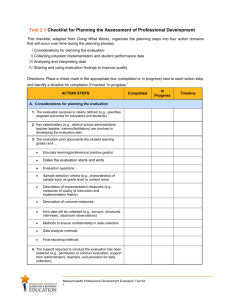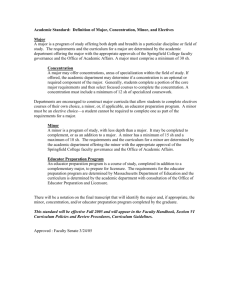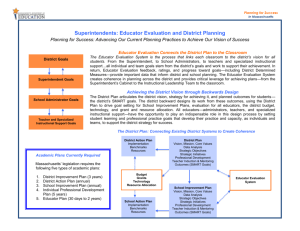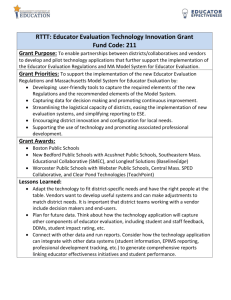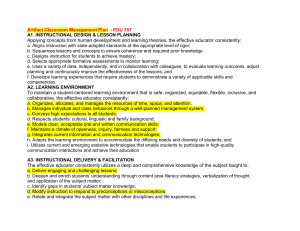School Administrators: Educator Evaluation and District/School
advertisement
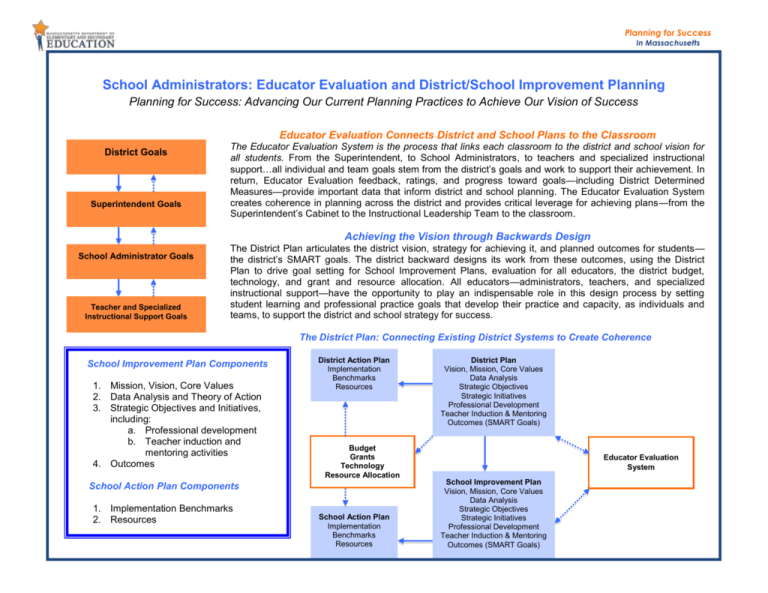
Planning for Success In Massachusetts School Administrators: Educator Evaluation and District/School Improvement Planning Planning for Success: Advancing Our Current Planning Practices to Achieve Our Vision of Success Educator Evaluation Connects District and School Plans to the Classroom District Goals Superintendent Goals The Educator Evaluation System is the process that links each classroom to the district and school vision for all students. From the Superintendent, to School Administrators, to teachers and specialized instructional support…all individual and team goals stem from the district’s goals and work to support their achievement. In return, Educator Evaluation feedback, ratings, and progress toward goals—including District Determined Measures—provide important data that inform district and school planning. The Educator Evaluation System creates coherence in planning across the district and provides critical leverage for achieving plans—from the Superintendent’s Cabinet to the Instructional Leadership Team to the classroom. Achieving the Vision through Backwards Design School Administrator Goals Teacher and Specialized Instructional Support Goals The District Plan articulates the district vision, strategy for achieving it, and planned outcomes for students— the district’s SMART goals. The district backward designs its work from these outcomes, using the District Plan to drive goal setting for School Improvement Plans, evaluation for all educators, the district budget, technology, and grant and resource allocation. All educators—administrators, teachers, and specialized instructional support—have the opportunity to play an indispensable role in this design process by setting student learning and professional practice goals that develop their practice and capacity, as individuals and teams, to support the district and school strategy for success. The District Plan: Connecting Existing District Systems to Create Coherence School Improvement Plan Components 1. Mission, Vision, Core Values 2. Data Analysis and Theory of Action 3. Strategic Objectives and Initiatives, including: a. Professional development b. Teacher induction and mentoring activities 4. Outcomes District Action Plan Implementation Benchmarks Resources Budget Grants Technology Resource Allocation School Action Plan Components 1. Implementation Benchmarks 2. Resources School Action Plan Implementation Benchmarks Resources District Plan Vision, Mission, Core Values Data Analysis Strategic Objectives Strategic Initiatives Professional Development Teacher Induction & Mentoring Outcomes (SMART Goals) Educator Evaluation System School Improvement Plan Vision, Mission, Core Values Data Analysis Strategic Objectives Strategic Initiatives Professional Development Teacher Induction & Mentoring Outcomes (SMART Goals) Planning for Success In Massachusetts Educator Evaluation Expectations for School Administrators: School Improvement Planning What are the planning-related behaviors identified in the Educator Evaluation rubric for School Administrators? What are the practices of effective schools in relation to school improvement planning? The Educator Evaluation System identifies planning related behaviors as part of its standards and indicators. The table below presents key behaviors as defined by the School Administrator rubric, and also presents planning-related characteristics of effective schools as defined by the Conditions for School Effectiveness. The Conditions for School Effectiveness is a research-based framework used by the Department of Elementary and Secondary Education in evaluating schools. Citations are included for all indicators. School Plan Components Mission, Vision, Core Values Data Analysis, Theory of Action Strategic Objectives, Strategic Initiatives Outcomes What Proficient School Administrators Do (Educator Evaluation Rubric) Develops, promotes, and models commitment to core values that guides the development of a succinct, results-oriented mission statement and ongoing decision making (IV-A-2) At all grade levels, continuously engages staff, students, families, and community members in developing a vision focused on student preparation for college and career readiness, civic engagement, and community contributions (IV-E-1) Identifies a range of appropriate data sources and effectively analyzes the data for decision-making purposes (I-E-1) Leads all educators and teams to reflect on the effectiveness of lessons, units, and interactions with students. Ensures that staff uses data, research, and best practices to adapt instruction to achieve improved results (IV-D-1) Uses multiple data sources to evaluate educator and school performance. Provides educator teams with disaggregated assessment data and assists faculty in identifying students who need additional support (I-E-3) Uses data to accurately assess the school’s strengths and areas for improvement to inform the creation of focused, measurable school and district goals (I-E-2) Develops school-based induction support for new teachers and/or faithfully implements the district’s induction strategy; organizes high-quality jobembedded professional development aligned with school and educator goals; and supports the career growth of effective educators by distributing leadership tasks and monitoring progress and development (II-B-2) Builds consensus within the school community around critical school decisions, employing a variety of strategies (IV-F-3) Develops a budget that aligns with the district’s vision, mission, and goals. Allocates and manages expenditures consistent with district/school-level goals and available resources (II-E-1) Supports educators and educator teams to develop and attain meaningful, actionable, and measurable professional practice and student learning goals (I-D-1) What Effective Schools Look Like (Conditions for School Effectiveness) The district and school take action to attract, develop, and retain an effective school leadership team that obtains staff commitment to improving student learning and implements a clearly defined mission and set of goals. (II) The principal acts strategically and purposefully in pursuit of a clear educational mission, while empowering others to do the same (II, Focus on Learning) Staff can state the school’s mission, understand the school’s improvement goals, and demonstrate a sense of ownership for both (II, Effective Planning) School leadership uses data and current research to drive decisions and measure progress toward school goals, and encourages staff to do so as well (II, Effective Decision-Making) The school jointly analyzes student performance data with families, community partners, and other constituent groups (X, Communication) Leaders use a variety of data to inform decisions related to budget, time on learning/scheduling, staffing/human resources, materials, and the physical plant. (XI, Strategic Use of Resources) The school has an improvement plan focused explicitly on instructional improvement and student learning; the plan drives school-level processes and practice (II, Effective Planning) The Instructional Leadership Team designs a coordinated PD plan that aligns with standards for school performance and student achievement as well as district and school priorities (VII, PD Plan/System) School leadership uses the school improvement plan to guide how time, personnel, funds, and other resources will be used to achieve the school’s mission (II, Effective Decision-Making) Leaders ensure that students, families, and community partners understand the school’s improvement plan and learning goals; leaders strategically leverage family and community resources in service of these goals (X, Strategic Relationships) The school improvement plan 1 )aligns with the district improvement plan, 2) reflects input from all staff, 3) is based on data, 4) accurately reflects the academic, social, and emotional needs of students, and 5) sets actionable and measurable goals that target improvement (II, Effective Planning)


